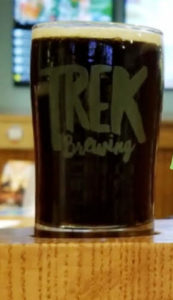Porter vs Stout
Hey guys! Happy Thursday! We had SO much fun at the Sip and Shop on Sunday. If you didn’t get a chance to make it out, you really missed out. We’re already excited about the possibility of doing another one in the future. All of our vendors were really incredible, and the day went really well even though the snow was falling.
We’re getting another Trek beer ready for release soon – a robust porter. It’s tasting delicious, you guys are going to LOVE it. We’ll have it on tap in the near future.
 I’m often asked the difference between stouts and porters when I’m bartending, and I usually say that the difference is slight. For today’s blog post, I figured I’d try to get you all a definitive answer on what makes a porter different from a stout.
I’m often asked the difference between stouts and porters when I’m bartending, and I usually say that the difference is slight. For today’s blog post, I figured I’d try to get you all a definitive answer on what makes a porter different from a stout.
While researching this topic, I can tell you that there is a lot more about what makes them similar than what makes them different. In general, both beers are dark in color and have a similar range of malty, roasty flavors. Both stouts and porters have a full bodied mouthfeel, and are usually described as somewhat “heavy”. If you like one of the styles, chances are good you’ll like the other.
The BJCP guidelines point out a few distinctive differences between the two- a porter is usually lighter in color ranging from light brown to dark brown, whereas a stout is dark brown to black. The porter usually does not contain large amounts of roasted barley, whereas a stout usually does. The various styles of both beers can however veer into the other’s territory, making it incredibly difficult to separate the two categories.
As far as the history goes, stout was actually a word used to describe a “strong” porter. Back in the day you could order a “porter” or a “stout-porter”. Somewhere in the midst of the 18th century historical brewing records show five different dark beer recipes, all from pale malt and brown malt only. These beers were called, porter, keeping porter, single stout, double stout, triple stout. The different beers were created by taking different mashes of the same grains, and so the only difference in between these beers was the strength. Later on in the 19th century, London’s brewers’ recipes for porter and stout begin to diverge, but the stouts were now getting LESS patent malt, making the stouts sweeter and less dry than the weaker porters.
The beer connoisseur notes, “When the “small brewer revolution” started in Britain and the United States in the 1970s, there was more than 250 years of different styles and strengths of stout and porter to choose from, and different brewers picked different sorts to recreate. The result is that, in some cases, some brewers now brew “porters” that are stronger than their stouts. The need to categorize beers for brewing competitions in the U.S. has meant a plethora of micro-managed style descriptions, few of which, however, have any historic validity.”
After researching the question “what is the difference between a stout an a porter?” I find that the answer is still about as clear as mud. Historically, a stout was a stronger version of a porter. Today, there is often lots of cross over between styles. If you enjoy one, you’re likely to enjoy the other. I’ve made no secret out of the fact that our Trail Majik Vanilla Stout is my all time favorite beer, and I can’t wait to try this porter with you all!
We’ll see you from across the bar! Cheers!
 " alt="Trek Brewing Company">
" alt="Trek Brewing Company">